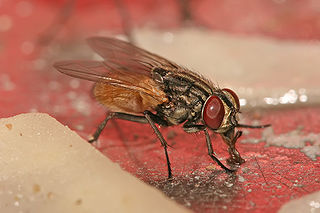
Miconia is a genus of flowering plants in the glory bush family, Melastomataceae, native to warm temperate to tropical regions of the Americas. The species are mostly shrubs and small to medium-sized trees up to 15 m tall. The generic name honours Catalan physician and botanist Francesc Micó. Some species are known by the common name johnnyberry.

Muscidae are a family of flies found in the superfamily Muscoidea.

Junín National Reserve is a protected area located in the region of Junín, Peru. One of its main purposes is to protect the ecosystem and biodiversity of Lake Junín and the surrounding Central Andean wet puna.

Limnanthes, the type genus of the family Limnanthaceae, consists of annual herbaceous plants commonly known as the meadowfoams. The seven species are all native to coastal and adjoining regions of western North America, where they typically grow in marshy habitats, such as the margins of vernal pools. Some are endemic to California

Eugenia floccosa is a species of plant in the family Myrtaceae. It is endemic to India. It is threatened by habitat loss.
Miconia floccosa is a species of plant in the family Melastomataceae. It is endemic to Peru.
Persea floccosa is a species of plant in the family Lauraceae. It is endemic to Mexico.

Rhipsalis floccosa is a species of plant in the family Cactaceae. It is found in Argentina, Bolivia, Brazil, Paraguay, Peru, and Venezuela. Its natural habitat is subtropical or tropical moist lowland forest. It is threatened by habitat loss.

Declana floccosa, the forest semilooper, is a moth of the family Geometridae. It is endemic to New Zealand. It was first described by Francis Walker in 1863 using specimens obtained from Colonel Bolton.

Hydrotaea is a genus of insects in the housefly family, Muscidae. They occur in most regions of the world but are more populous in warmer climates. They are often found on feces in summer months, and are therefore generally found in close proximity to livestock. Among the 130 known species in this genus, one of the most commonly recognized is the dump fly.

Limnanthes floccosa, or woolly meadowfoam, is a species of meadowfoam found in Northern California and Southern Oregon, in the United States. Most of the subspecies have highly restricted distributions and are listed as critical or endangered.

Chaetanthera is a genus of South American flowering plants in the daisy family.
Hydrotaea militaris is a species of fly in the family Muscidae.
Hydrotaea armipes is a species of house flies, etc. in the family Muscidae. It is found in Europe.

Hydrotaea ignava is a species of house flies, etc. in the family Muscidae. It is found in Europe.
Gozmanyina majestus is a species of cosmochthoniid in the family Cosmochthoniidae.
Asphondylia floccosa, the woolly stem gall midge, is a species of gall midges in the family Cecidomyiidae.
Hydrotaea houghi is a species of house flies, etc. in the family Muscidae.

Hydrotaea aenescens, known generally as black dump fly, is a species of house flies, etc. in the family Muscidae. Other common names include the black garbage fly and dump fly. It is found in Europe.
Newsteadia floccosa, the boreal ensign scale, is a species of scale insect in the family Ortheziidae. It is native to Europe and is found in the soil and amongst plant litter and mosses on the ground.










